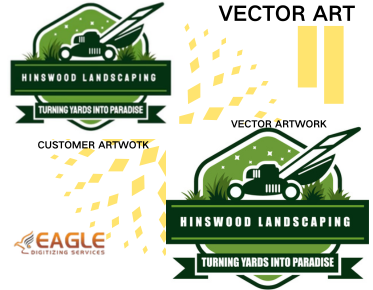Decoding Embroidery Program Files: A Beginner's Guide
The
Evolution of Embroidery: From Hand-Stitching to Digital Files
Embroidery, a timeless art form, hasseen a
remarkable transformation from intricate hand-stitching to the precision of
digital designs. Gone are the days when every stitch had to be meticulously
placed by hand. Today, embroidery machines, guided by sophisticated program
files, create complex patterns with remarkable accuracy and speed. This
evolution has opened up new possibilities for hobbyists and professionals
alike, blending traditional craftsmanship with modern technology. For the best digitizing service, please feel free to contact us.
Why Understanding Embroidery Program Files Matters
In the world of digital embroidery, understanding
program files is essential. These files are the lifeblood of your embroidery machine, directing every movement to produce your desired design. Knowing how
to use and manipulate these files not only enhances your creative capabilities
but also ensures that your projects are executed flawlessly. Whether you're
downloading patterns, customizing designs, or creating your own from scratch,
mastery of embroidery program files is key to unlocking your full potential in
this craft.
Understanding Embroidery Program Files
What Exactly Are
Embroidery Program Files?
Embroidery program files are digital blueprints
that instruct your embroidery machine on how to stitch a design. They contain
detailed information about stitch types, sequences, and colors, enabling the
machine to replicate the design accurately. These files bridge the gap between
digital designs and physical fabric, transforming pixels into threads.
Key Components of
Embroidery Files: Stitch Data and Machine Instructions
Embroidery files consist of two main components:
stitch data and machine instructions. Stitch data includes the precise
coordinates for each stitch, while machine instructions dictate the order of operations,
thread color changes, and other essential parameters. Together, these
components ensure that your embroidery machine follows the correct path to
recreate the design.
Common Embroidery File
Formats: PES, DST, EXP, and More
Embroidery files come in various formats, each compatible with different types of machines. The most common formats include PES (used by Brother machines), DST (an industry standard for commercial machines), EXP (preferred by Bernina users), and JEF (designed for Janome machines). Understanding these formats helps you choose the right files for your machine and avoid compatibility issues.
Types of Embroidery Program Files
Design Files: The
Blueprint of Your Embroidery
Design files are the heart of any embroidery
project. They contain the artistic blueprint of your design, including detailed
stitch data and color information. These files dictate the visual outcome of
your embroidery, ensuring that the machine stitches the pattern as intended.
Machine Files: Direct
Instructions for Your Embroidery Machine
Machine files, on the other hand, provide direct
instructions to your embroidery machine. These files translate the design into
a language that the machine can understand, guiding every needle movement and
thread change. Ensuring that your machine can read and execute these files
correctly is crucial for successful embroidery.
Supporting Files: Color
Charts, Thread Lists, and More
Supporting files, such as color charts and thread lists, are essential for achieving accurate color representation in your designs. These files provide a reference for matching thread colors, ensuring consistency and precision in your embroidery projects. They also help you plan and organize your materials effectively.
Popular Embroidery File Formats
PES: The Go-To Format
for Brother Machines
PES files are widely used by Brother embroidery
machines. Known for their compatibility and reliability, PES files support a
variety of stitch types and are easy to edit. They are a popular choice for
both beginners and experienced embroiderers using Brother machines.
DST: The Industry
Standard for Commercial Machines
DST files are the industry standard for
commercial embroidery machines. Developed by Tajima, these files are known for
their robustness and versatility. They are compatible with many different
brands and models, making them a go-to format for professional embroiderers.
EXP: Preferred by
Bernina Users
EXP files are commonly used by Bernina embroidery
machines. These files offer excellent support for complex designs and are
highly customizable. Bernina users appreciate the flexibility and precision
that EXP files provide, making them a preferred choice for intricate projects.
JEF: Designed for Janome
Machines
JEF files are intended exclusively for Janome embroidery machines. These files are user-friendly and support a wide range of design elements, making them ideal for Janome users. They ensure smooth and accurate stitching, enhancing the overall embroidery experience.
How to Choose the Right File Format
Considering Your
Machine’s Compatibility
Choosing the right file format starts with
considering your machine’s compatibility. Each embroidery machine has specific
file formats it can read, so it's crucial to select files that match your
machine's requirements. Refer to your machine's manual or manufacturer’s
website for compatibility information.
Understanding the
Features of Each File Format
Different file formats offer varying features and
capabilities. Some formats support more complex stitch types and color changes,
while others are simpler but more universally compatible. Understanding these
features helps you choose the format that best suits your project needs and
machine capabilities.
Tips for Converting
Between File Formats
If you encounter a design in an incompatible format, converting between file formats is often necessary. Use embroidery software like Wilcom or Embrilliance to convert files while preserving design integrity. Always test the converted file on a sample fabric to ensure it works correctly with your machine.
Where to Find Embroidery Program Files
Online Marketplaces:
Etsy, EmbroideryDesigns.com, and More
Online marketplaces like Etsy and
EmbroideryDesigns.com offer a vast selection of embroidery program files. These
platforms provide designs from various creators, ensuring a wide range of
styles and themes. They are excellent sources for unique and high-quality
embroidery patterns.
Free Resources: Blogs,
Forums, and Community Websites
Free resources, such as blogs, forums, and
community websites, are great places to find embroidery program files without
spending a dime. Websites like Urban Threads and SewForum offer free designs
and foster communities where users share patterns and advice.
Creating Your Own
Designs: Software and Tools
Creating your own embroidery designs allows for complete customization and creativity. Software like Hatch, Wilcom, and Inkscape with Ink/Stitch provide powerful tools for digitizing your artwork. Experimenting with these tools enables you to produce original designs tailored to your specific projects.
Downloading and Organizing Embroidery Files
Best Practices for
Downloading Files
When downloading embroidery files, ensure they
come from reputable sources to avoid corrupted files and malware. Always
download files in the correct format for your machine and verify their quality
before use. Keep your downloads organized by immediately saving them to
designated folders.
Creating a Filing System
for Easy Access
Creating a filing system for your embroidery
files simplifies access and keeps your collection manageable. Organize files
into categories such as themes, projects, or file formats. Use clear and
consistent naming conventions to make searching for specific designs easier.
Backing Up Your
Embroidery File Collection
Backing up your embroidery file collection is essential to prevent loss due to hardware failure or accidental deletion. Use external hard drives, cloud storage, or both to create secure backups. Regularly update your backups to ensure all your latest files are saved.
Software for Viewing and Editing Embroidery Files
Essential Embroidery
Software: Wilcom, Hatch, Embrilliance
Essential embroidery software like Wilcom, Hatch,
and Embrilliance offers comprehensive tools for viewing and editing embroidery
files. These programs provide advanced features for digitizing, customizing,
and perfecting your designs, making them indispensable for serious
embroiderers.
Free Software Options:
Inkscape with Ink/Stitch, My Editor
Free software options, such as Inkscape with
Ink/Stitch and My Editor, provide powerful capabilities without the cost. While
they may not have all the features of paid software, they offer robust tools
for basic editing and customization. These programs are excellent starting
points for beginners.
Features to Look for in
Embroidery Software
When choosing embroidery software, look for features like ease of use, compatibility with various file formats, and advanced editing tools. Other important features include design preview options, color management, and the ability to convert between different file formats.
How to Use Embroidery Program Files with Your Machine
Preparing Your Machine:
Ensuring Compatibility
Before using embroidery program files with your
machine, ensure compatibility by checking the file format and machine settings.
Update your machine’s firmware if necessary and consult the manual for specific
preparation instructions.
Transferring Files to
Your Embroidery Machine
Transferring files to your embroidery machine can
be done via a USB drive, memory card, or direct computer connection. Follow
your machine’s guidelines for transferring files, and ensure they are saved in
the correct format and folder structure.
Selecting and Setting Up
Your Design
Once the file is transferred, select and set up your design on the machine. Adjust settings such as size, orientation, and color changes to match your project requirements. Perform a test stitch on scrap fabric to verify the setup before starting the final embroidery.
Troubleshooting Common Issues
Dealing with File
Compatibility Problems
File compatibility issues can occur when using
embroidery program files across different machines or software. Use file
conversion tools to convert between formats while preserving design integrity.
Verify compatibility with your machine before proceeding with embroidery.
Fixing Stitching Errors
and Misalignments
Stitching errors and misalignments can disrupt
the quality of your embroidery. Check for correct hoop tension, thread tension,
and needle condition to prevent issues during stitching. Use embroidery
software to adjust stitch density, underlay, and pull compensation for smoother
results.
Tips for Smooth and
Trouble-Free Embroidery
Achieving smooth and trouble-free embroidery involves meticulous preparation and attention to detail. Use quality embroidery threads and needles suitable for your fabric type. Clean and maintain your embroidery machine regularly to prevent thread jams and mechanical issues. Practice good hooping techniques to ensure fabric stability during stitching.
Staying Up-to-Date with Trends
Latest Trends in
Embroidery Design
Stay informed about the latest trends in
embroidery design to keep your projects fresh and appealing. Follow industry
publications, attend trade shows, and explore online galleries to discover
emerging styles, color palettes, and motifs.
Innovative Uses of
Embroidery Program Files
Explore innovative uses of embroidery program
files beyond traditional applications. Experiment with mixed media, digital
embroidery art, and interactive textiles to push the boundaries of conventional
embroidery techniques.
Keeping Your Skills
Current with Emerging Techniques
Continuously improve your embroidery skills by learning emerging techniques and technologies. Attend workshops, enroll in advanced courses, and participate in skill-building challenges to stay ahead of industry developments. Embrace new tools and methods to expand your creative repertoire.
Eagle Digitizing provides embroidery digitizing services. Mastering embroidery program files empowers you to unleash your creativity and achieve professional-quality results. From understanding file formats to advanced stitching techniques, each aspect contributes to your success as an embroiderer.
Embarking on your embroidery journey with
confidence and enthusiasm opens doors to endless possibilities. Whether you’re
a beginner or a seasoned embroiderer, each project offers a chance to learn,
grow, and create beautiful works of art with embroidery program files. Enjoy
the process, hone your skills, and let your creativity flourish in every
stitch. Happy embroidering!



